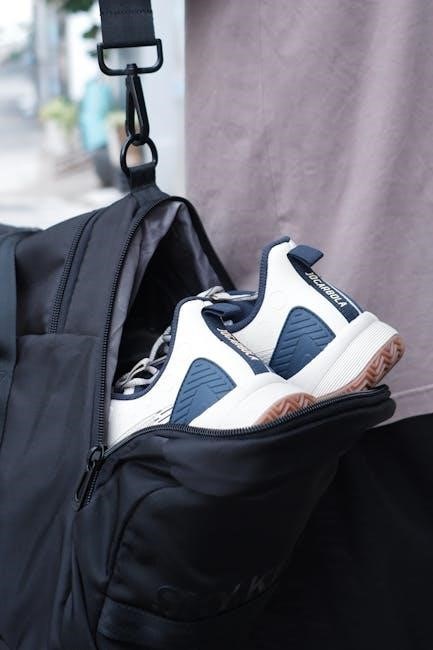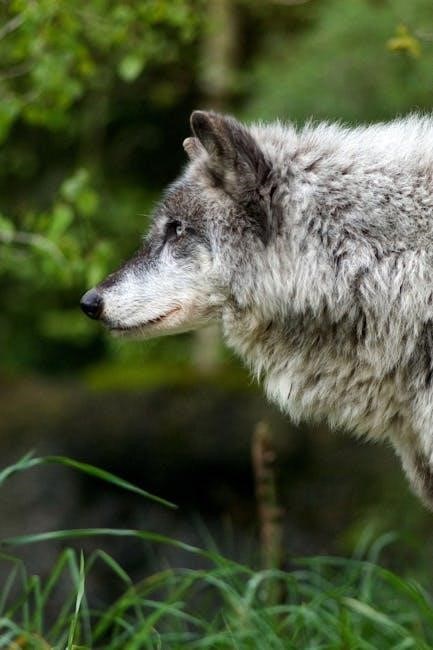alaska packing list pdf
Welcome to the ultimate Alaska packing guide! Explore the vast wilderness, stunning landscapes, and unique climate of Alaska with a well-prepared packing list for an unforgettable adventure․
1․1 Overview of Alaska’s Climate and Geography
Alaska is renowned for its vast and diverse landscapes, ranging from Arctic tundras to lush rainforests and glacier-carved fjords․ The climate varies significantly by region, with extreme cold in the north and milder temperatures in the southeast; Summer offers long daylight hours, while winters are harsh, with limited sunlight and freezing temperatures․ The state’s geography includes rugged mountains, expansive coastlines, and dense wilderness areas, making it a unique destination for outdoor adventures․ Understanding these climatic and geographical features is crucial for preparing an effective packing list tailored to Alaska’s conditions․ Whether hiking, camping, or exploring wildlife, the state’s natural beauty and extreme weather demand careful planning and appropriate gear․
1․2 Importance of Proper Packing for Alaska
Packing appropriately for Alaska is essential due to its unforgiving climate and remote wilderness․ Extreme weather conditions, such as freezing temperatures and sudden rain, can make improper clothing choices dangerous․ Additionally, many areas are far from urban centers, making it difficult to purchase supplies once you arrive․ A well-organized packing list ensures you stay safe, comfortable, and prepared for various activities․ Whether you’re hiking, camping, or exploring, the right gear can make the difference between an enjoyable trip and a challenging one․ Proper packing also helps protect the environment by minimizing waste and reducing the need for last-minute purchases․ Planning your Alaska packing list carefully is the first step toward a successful and memorable adventure․

Essential Items for an Alaska Packing List
Packing the right gear is vital for Alaska’s unpredictable climate and outdoor adventures․ Essentials include layered clothing, waterproof items, sturdy footwear, and reliable outdoor equipment for safety and comfort․
2․1 Clothing
When packing for Alaska, clothing choices are crucial due to the state’s unpredictable and often extreme weather conditions․ Layering is key: start with moisture-wicking base layers, add insulating mid-layers like fleece, and finish with a waterproof and windproof outer shell․ Thermal underwear made from materials like merino wool or synthetic fabrics is essential for cold days․ Include versatile pieces such as lightweight rain jackets, warm sweaters, and durable pants that can withstand rugged outdoor activities․ Don’t forget accessories like hats, gloves, scarves, and warm socks to protect against the cold․ For summer trips, pack breathable clothing to manage warmer temperatures, while winter travel requires heavy-duty parkas and thermally insulated gear․ Always check the weather forecast before your trip to ensure your clothing choices match the conditions․
2․2 Footwear
Footwear is a critical component of your Alaska packing list, as it must withstand the state’s rugged terrain and unpredictable weather․ Choose durable, waterproof boots with excellent traction for hiking and outdoor activities․ Insulated, waterproof boots rated for subzero temperatures are essential for winter trips․ For summer adventures, consider lightweight, breathable hiking shoes or trail runners․ Bring moisture-wicking socks to keep your feet dry and comfortable․ Include a pair of sturdy, waterproof boots for wetland or snowy conditions․ Sandals or water shoes are useful for river crossings or beach activities․ Ensure your footwear is broken in before your trip to avoid blisters․ Pack extra socks and consider gaiters for added protection․ Proper footwear will enhance your comfort and safety in Alaska’s diverse environments․
2․3 Outdoor Gear
Packing the right outdoor gear is essential for navigating Alaska’s rugged landscapes․ Bring a durable, waterproof tent and a sleeping bag rated for extreme cold․ A sturdy backpack with multiple compartments will help organize your essentials․ Include a portable stove, camping cookware, and a water filtration system for safe drinking water․ Don’t forget a compass, map, and GPS device for navigation․ A headlamp or flashlight is crucial for evening activities․ Bear-resistant containers are a must for storing food in bear country․ Insect repellent and a first aid kit are also vital․ Consider a portable power bank for charging devices in remote areas․ Proper outdoor gear ensures safety and comfort while exploring Alaska’s vast wilderness․
2․4 Toiletries
Essential toiletries ensure personal hygiene and comfort during your Alaska adventure․ Pack a travel-sized toothbrush, toothpaste, and dental floss․ Include biodegradable soap, shampoo, and conditioner for eco-friendly camping․ Moisturizer and lip balm with SPF protect against harsh winds and sun․ Bring a comb, shaving kit, and makeup essentials if needed․ Feminine hygiene products, hand sanitizer, and wet wipes are must-haves․ A reusable water bottle and any personal medications should also be included․ Don’t forget a small first aid kit with pain relievers and band-aids․ Keep items in a waterproof bag to prevent damage․ Remember to pack biodegradable options to minimize environmental impact while camping․ These toiletries will keep you fresh and prepared for any situation in Alaska’s wilderness․

Seasonal Packing Considerations
Alaska’s varying seasons require tailored packing strategies to match extreme weather conditions, ensuring comfort and safety during your trip․
3․1 Summer Packing Tips
For summer in Alaska, pack lightweight, breathable clothing suitable for mild temperatures (40–80°F)․ Include moisture-wicking fabrics, quick-drying shirts, and convertible pants․ Bring a lightweight rain jacket, as summer showers are common․ Don’t forget a hat, sunglasses, and SPF 30 sunscreen for sun protection․ Insect repellent with DEET is essential to combat mosquitoes․ Sturdy, waterproof hiking boots are a must for trails, which can be wet and muddy․ Add a warm layer for cooler mornings and evenings, such as a fleece or lightweight jacket․ Avoid heavy clothing and focus on versatile, layered pieces․ Check weather forecasts before your trip to ensure preparedness for varying conditions․ Keep gear organized with packing cubes or a sturdy backpack for easy access․
3․2 Winter Packing Tips
For a winter trip to Alaska, prioritize warmth and durability․ Pack thermal base layers made of merino wool or fleece, followed by insulating mid-layers like down or synthetic jackets․ A heavy, waterproof parka with a hood is essential to protect against harsh winds and snow․ Insulated, waterproof boots with good grip are crucial for icy surfaces․ Bring waterproof gloves or mittens, a neck gaiter, and a warm beanie to prevent heat loss․ Include thermal socks and consider bringing extra pairs․ Don’t forget UV-protective eyewear, as snow glare can be intense․ A portable humidifier may help combat dry indoor air․ Lastly, pack hand and toe warmers for extra comfort in extreme cold․ Always check weather forecasts before your trip to ensure preparedness for potential extreme conditions․
3․3 Spring and Fall Packing Tips
Spring and fall in Alaska bring mild temperatures but unpredictable weather․ Pack layers of breathable, moisture-wicking fabrics to adapt to changing conditions․ Include a mid-weight fleece jacket and a waterproof windbreaker or raincoat․ Insulated, waterproof boots are still essential for wet or muddy terrain․ Bring a warm hat, gloves, and a scarf, as mornings and evenings can be chilly․ Don’t forget insect repellent, as mosquitoes and bugs are active during these seasons․ Opt for versatile clothing that can be easily added or removed․ Consider a lightweight daypack for day trips and ensure all gear is water-resistant․ Check the weather forecast before your trip to prepare for potential rain or cooler days․ Pack smart to stay comfortable in Alaska’s transitional seasons․

Outdoor Activities and Specialized Gear
Alaska offers endless outdoor adventures, requiring tailored gear for hiking, camping, fishing, and wildlife viewing․ Sturdy boots, trekking poles, and waterproof gear are essential for rugged terrains and unpredictable weather․
- Hiking: Sturdy boots, trekking poles, and a backpack․
- Camping: Tent, sleeping bag, and camping stove․
- Fishing: Rods, reels, and lures suitable for local species․
- Wildlife Viewing: Binoculars and a camera for capturing moments․
Ensure gear is durable, waterproof, and suitable for extreme conditions to maximize your Alaskan adventure․
4․1 Hiking and Camping Gear
For hiking and camping in Alaska’s rugged wilderness, durable and versatile gear is essential․ A sturdy backpack, waterproof tent, and insulated sleeping bag are must-haves for overnight stays․
- Hiking Boots: Waterproof, ankle-high boots with good traction for uneven terrain․
- Trekking Poles: Helpful for balance on steep or muddy trails․
- Camping Stove: Portable and reliable for cooking in remote areas․
- Navigation Tools: GPS devices or maps to stay on track․
- Headlamp: Essential for navigating in low-light conditions․
Always prioritize gear that is both durable and lightweight to handle Alaska’s challenging environment while keeping your pack manageable․
4․2 Fishing and Hunting Gear
Fishing and hunting in Alaska require specialized gear to ensure success and safety․ For anglers, a durable fishing rod, reel, and tackle box with lures suitable for local species are essential․ Waders or waterproof boots are crucial for river fishing․ Hunters should pack a reliable rifle, scopes, and ammunition, along with camouflage clothing and tree stands for concealment․ Ice fishing enthusiasts will need augers, ice picks, and thermal gear․ Always check local regulations for licensing requirements and gear restrictions․ Properly storing and transporting gear is vital to withstand Alaska’s rugged conditions․ Ensure all equipment is durable, portable, and suitable for the specific adventure to maximize your outdoor experience․
4․3 Wildlife Viewing Equipment
For an immersive wildlife viewing experience in Alaska, pack essential gear to maximize your observations․ Binoculars are a must for spotting animals from a distance, while a spotting scope provides higher magnification for detailed views․ A field guide to Alaskan wildlife will help identify species․ Include a camera with a telephoto lens for capturing memories․ A tripod ensures stability for clear photos or videos․ Don’t forget extra batteries, memory cards, and a portable charger․ Comfortable, camouflaged clothing and a hat reduce visibility․ A backpack with water, snacks, and a map keeps you prepared for extended excursions․ Respect wildlife by maintaining a safe distance and using ethical viewing practices to avoid disrupting their natural behavior․

Travel Documents and Miscellaneous Items
Pack essential documents like your passport, ID, travel insurance, and tickets․ Bring a reusable water bottle, flashlight, and portable charger․ Include a map, first aid kit, and small essentials․
5․1 Identification and Travel Documents
Ensure you carry essential identification and travel documents for a smooth journey․ Pack your passport, driver’s license, or state ID, and travel insurance documents․ Bring printed or digital copies of flight tickets, hotel reservations, and activity bookings․ Include a detailed itinerary with emergency contact information․ Don’t forget health insurance cards and any required visas․ Organize these items in a waterproof pouch or folder for easy access․
Make digital backups of your documents and store them securely․ Leave a copy with a trusted friend or family member in case of emergencies․ Double-check expiration dates for passports and IDs to avoid travel disruptions․
5․2 First Aid Kit
A well-stocked first aid kit is crucial for any Alaska trip․ Include band-aids, antiseptic wipes, pain relievers, and personal medications․ Add cold and flu remedies, as remote areas may limit access to pharmacies․ Pack blister care for hiking and gloves for handling sharp objects․ Don’t forget antihistamines for allergic reactions and hydrocortisone cream for skin irritations․ Include a first aid manual for guidance․ Consider adding altitude sickness medication if visiting high elevations․ Ensure all items are easily accessible and stored in a waterproof container․ Customize the kit based on your itinerary and health needs․ A prepared first aid kit can prevent minor issues from escalating and keep you safe in remote areas․
5․3 Miscellaneous Essentials
Packing miscellaneous items ensures you’re prepared for unexpected situations․ Include a reusable water bottle, portable charger, and power bank for keeping devices charged․ A small flashlight or headlamp is handy for low-light conditions, while a multi-tool or pocket knife offers versatility․ Don’t forget extra batteries, a travel-sized umbrella, and a reusable container for storage․ Bring a small notebook and pen for journaling or note-taking․ A sewing kit and duct tape can repair gear on the go․ Pack travel-sized games or books for downtime․ Include a small supply of snacks, like energy bars or nuts, to keep energy levels up․ These items may seem minor but can significantly enhance your comfort and convenience during your Alaskan adventure․
What to Avoid Packing
Avoid overpacking bulky items and unnecessary gear․ Steer clear of heavy luggage and formal wear; Opt for multi-purpose essentials to ensure a lightweight and efficient travel experience․
6․1 Overpacking
Overpacking is a common mistake that can hinder your Alaska adventure․ Heavy luggage and bulky items are unnecessary, as they occupy valuable space and add unnecessary weight․ Stick to multi-purpose gear and lightweight clothing that can be layered for varying conditions․ Avoid bringing items that can be easily purchased locally, such as toiletries or rain gear․ Focus on essentials like sturdy footwear, warm layers, and waterproof items․ Consider the specific activities you’ll be doing and pack accordingly․ Leave behind non-essential items to ensure a seamless and efficient travel experience․ Remember, less is more in Alaska’s vast wilderness, where practicality and mobility are key to enjoying your trip․ Always check the weather forecast before finalizing your packing list to avoid overpreparing for unlikely conditions․
6․2 Inappropriate Clothing
Packing inappropriate clothing for Alaska can ruin your experience․ Avoid bringing overly formal or delicate items that are impractical for outdoor adventures․ Heavy, bulky outfits are unnecessary in summer, while lightweight fabrics may fail to protect you in winter․ Opt for durable, weather-resistant materials and layers that can adapt to temperature changes․ Steer clear of high-maintenance fabrics that require special care․ Bright colors may attract insects in summer, so consider neutral tones․ Avoid single-purpose items like evening gowns or suits unless necessary for specific events․ Choose versatile, comfortable clothing suitable for hiking, camping, or exploring․ Ensure your wardrobe aligns with Alaska’s rugged environment and the activities you plan to enjoy during your stay․
6․3 Unnecessary Items
When packing for Alaska, it’s crucial to avoid bringing unnecessary items that add bulk without value․ Luxury toiletries, designer clothing, or bulky gadgets often go unused․ Avoid overpacking electronics like laptops unless essential, as Wi-Fi access can be limited․ Expensive jewelry or delicate accessories are impractical in rugged outdoor settings․ Single-use items like disposable utensils or excessive paperwork waste space and aren’t eco-friendly․ Instead, opt for multi-purpose products and lightweight alternatives․ Leave non-essential luxury items at home to save space and reduce clutter․ Focus on packing functional, versatile gear tailored to your itinerary․ Remember, Alaska’s wilderness demands practicality, so prioritize essentials over indulgences for a stress-free adventure․

Budget and Shopping Tips
Plan your packing budget wisely by shopping during sales or renting gear․ Consider secondhand stores for affordable options and prioritize essential items over luxury purchases․
7․1 Budgeting for Packing
Creating a budget for your Alaska packing list is essential to avoid overspending․ Start by identifying must-have items and allocate funds accordingly․ Consider the durability and versatility of gear to ensure long-term value․ Research prices online and look for seasonal sales or discounts․ Secondhand stores and rental options can significantly reduce costs․ Prioritize essential items like thermal clothing and sturdy footwear over luxury accessories․ Set a realistic budget range and stick to it to maintain financial balance․ Remember, smart packing is about functionality, not extravagance․ By planning carefully, you can stay within your budget while ensuring you’re well-prepared for Alaska’s unique environment․
7․2 Shopping for Gear
Shopping for Alaska-specific gear requires a strategic approach to ensure you find high-quality items within your budget․ Start by researching reputable outdoor brands known for durability in harsh climates․ Online marketplaces like REI, Amazon, and Moosejaw often offer a wide selection with customer reviews․ Visit local outdoor stores for personalized recommendations and fittings․ Use specific keywords like “thermal layers” or “waterproof hiking boots” to streamline your search․ Consider renting bulky items like snowshoes or camping equipment to save space and money․ Additionally, look for seasonal sales or clearance sections to purchase gear at discounted prices․ Always read product descriptions carefully and compare features to ensure you’re buying what you need for Alaska’s unique conditions․
7․3 Rental Options
Renting gear is a cost-effective and space-saving solution for your Alaska trip․ Many outdoor equipment rental shops in Alaska offer high-quality items like camping gear, skis, and snowshoes․ Online platforms also provide rental services, allowing you to reserve equipment in advance․ This option is ideal for bulky items you may not need after your trip․ Additionally, local outfitters often rent fishing gear, bear-proof containers, and other specialized equipment․ Renting ensures you have access to gear tailored to Alaska’s conditions without the long-term investment․ Be sure to research and book rentals early, especially during peak travel seasons, to secure availability․ This approach helps you stay prepared while keeping your luggage light and your expenses manageable․

Clothing Care and Maintenance
Properly wash and dry clothing before packing, removing stains promptly․ Store items in airtight bags to protect from moisture and pests․ Regularly maintain water-repellent treatments for outdoor gear․
8․1 Washing and Drying Instructions
When washing clothing for your Alaska trip, use a mild detergent suitable for outdoor fabrics․ Avoid bleach or fabric softeners, as they can degrade water-repellent treatments․ Wash similar colors together to prevent dye bleeding․ For waterproof items, ensure they are fully dry before packing․ Air-drying is recommended, especially for waterproof gear, as high heat can damage coatings․ For synthetic fabrics like fleece, low-heat tumble drying is acceptable․ Always check care labels for specific instructions, especially for high-performance materials․ After washing, reapply waterproof treatments if necessary․ Properly dried and maintained clothing ensures longevity and performance in Alaska’s rugged environment․ Hand-wash delicate items, and store all gear in a clean, dry space to prevent mildew․ Regular care extends the life of your outdoor apparel, keeping you prepared for any adventure․ Always inspect items before packing to ensure they are in optimal condition․
8․2 Stain Removal Tips
When dealing with stains on your Alaska gear, act quickly for best results․ For mud or dirt, scrape off excess and rinse with cold water before washing․ For grease or oil-based stains, apply dish soap directly and let it sit for 10 minutes․ Bloodstains can be treated with cold water and a mild detergent, while food stains benefit from pre-treatment with stain remover․ Avoid using bleach on waterproof fabrics, as it can damage coatings․ Always check care labels for specific instructions․ For tough stains, repeat treatment before washing․ Using eco-friendly products is recommended for outdoor gear․ Proper stain removal ensures your clothing remains functional and ready for adventures in Alaska’s rugged terrain․
8․3 Storage Tips
Proper storage of your Alaska gear is essential to maintain its quality and longevity․ Store clothing and equipment in a cool, dry place to prevent mold and mildew․ Use airtight containers or ziplock bags for items like socks and undergarments to keep them fresh․ For outerwear, consider using garment bags to protect against dust․ Check all gear for damage before storing and clean items thoroughly to avoid stains setting in․ Avoid stacking heavy items on top of delicate gear․ For seasonal items, label containers clearly for easy access․ Consider using silica packets to absorb moisture and prevent rust or corrosion․ Regularly inspect stored items to ensure they remain in good condition․ Proper storage ensures your Alaska packing list stays ready for future adventures․
With a well-planned Alaska packing list, you’re ready for an unforgettable adventure․ Stay prepared, enjoy the stunning landscapes, and make lasting memories in the Last Frontier!
9․1 Final Checklist
Before your Alaska adventure, ensure you have all essentials packed․ Review your list for clothing, footwear, outdoor gear, toiletries, and travel documents․ Check weather-appropriate items like rain gear or thermal layers․ Confirm you have a first aid kit, reusable water bottle, and wildlife viewing equipment․ Verify identification, travel insurance, and reservations are in order․ Double-check seasonal specifics, such as insect repellent for summer or insulated gear for winter․ Pack a portable charger for electronics and a reusable bag for souvenirs․ Review your budget and ensure no unnecessary items are included․ Finally, confirm your luggage meets size and weight requirements․ A well-organized checklist guarantees a smooth and enjoyable trip to Alaska․
9․2 Last-Minute Tips
Before departing, double-check the weather forecast for your destination and adjust your packing list accordingly․ Notify your bank of travel dates to avoid card issues․ Charge all electronics and pack a portable charger for emergencies; Reconfirm reservations for accommodations, tours, and transportation․ Ensure all essential documents, such as your passport and travel insurance, are easily accessible․ Review your budget one last time to avoid overspending․ Consider last-minute gear rentals if needed․ Pack a small day bag for excursions and ensure it includes essentials like snacks, a water bottle, and extra layers․ Finally, take a moment to mentally prepare for the adventure ahead and enjoy the journey!


